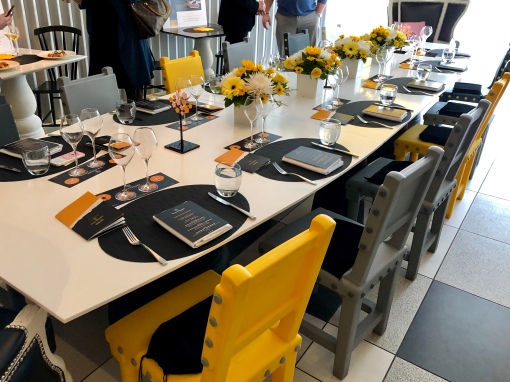By Peter Vetsch
Ladies and gentlemen, there is a week left in Advent. As our December wine journey starts wending its way to the finish line, Tyler yesterday rightly complimented the calendar on its diversity and variety to date, commenting on how every day has been a fresh and exciting adventure to a different place, grape or style. Perhaps that triggered the jinx, or perhaps we fell into a trap set by the 7s, but tonight’s Day 17 reveals a strikingly familiar face, one just seen back on Day 7: Clarence Dillon’s Clarendelle. Whereas our first week of Advent ended with the Clarendelle red, our last week of the calendar starts with the 2018 Clarendelle Bordeaux Blanc.

Tyler covered the history of Clarendelle in detail in Day 7’s entry, noting that it was a recent effort of Clarence Dillon Wines to create a brand-based and price-conscious Bordeaux wine “inspired by Haut-Brion”, another winery forming part of the Dillon empire, with some help from the Haut-Brion winemaking team. I’m not sure I fully buy this motto, which is notably plastered on this half-bottle’s front label; “inspired by Haut-Brion” is largely code for “I also own Haut-Brion and can say this without being sued”. That said, if I owned Haut-Brion I would probably put its name on everything else I owned too. The man who purchased the great First Growth in 1935 has a few impressive buys on his resume: a legendary financier, Dillon pulled the Goodyear company out of receivership, and then later bought Dodge, and then Chrysler, all within the span of six years and all before dropping 2,300,000 francs on Haut-Brion. He was basically the Monopoly man. His son, also named Clarence Dillon, was the US Secretary of the Treasury and the Ambassador to France. And the prince of Luxembourg is in the family tree somewhere. You get the idea.

White wines used to make up half of Bordeaux’s production not even 60 years ago; now they are less than 10%, as a combination of soil-based vineyard replanting and shifting consumer tastes have seen the region focus more and more on Cab- and Merlot-based red blends. Most of Bordeaux’s whites are blends of Sauvignon Blanc and Semillon, with a smattering of Muscadelle here and there (I initially thought these three were the only permitted white grapes of Bordeaux, only to be roundly corrected by the following Rolodex of allowable white varietals: Sauvignon Gris, Ugni Blanc, Colombard, Merlot Blanc (??), Ondenc and Mauzac [at least possibly made-up], Albarino, Petit Manseng and Liliorila). There are less than 1,000 hectares of Muscadelle planted in all of Bordeaux, the bulk of which is used as a floral-accented blending component to sweet wines like Sauternes. It is a delicate, fragile and discreet grape, not known for prominence either in any part of its flavour profile or in any notable white Bordeaux blends. Its name notwithstanding, it is not related at all to the Muscat grape family, instead arriving on the scene as a crossing between an unknown vinifera parent and Gouais Blanc, a grape that’s utterly un-noteworthy on its own but has some remarkable procreation skills, acting as parent for a large swath of vinifera grapes (like Chardonnay) that we currently know and love.

I mention all of this because my first thought when I saw the blend composition on this bottle, uttered out loud in spite of myself, was: “That is a sh*t ton of Muscadelle.” The Clarendelle website helpfully advises that they sometimes add “a touch of Muscadelle in certain vintages” of their Bordeaux Blanc; the 2018 vintage is 42% Semillon, 30% Sauvignon Blanc and 28% Muscadelle. I have never seen that much Muscadelle in a single wine ever (although there is apparently a 100% Muscadelle Bordeaux Blanc out there, which I now must track down). The combo of Muscadelle and Semillon means that 70% of this white is made up of restrained, reticent varietals — can the Sauvignon Blanc minority pump up the volume and bring out the extrovert in this wine? (Spoiler: no.)

Cork Rating: 5.5/10 (Elegant font and graphics, although the composites aren’t my favourites.)
The 2018 Clarendelle is a pale but vibrant lemon colour and emerges elegantly if cautiously in the glass. Its strikingly alpine, floral nose conjures up crystal clear images of that mountaintop field of flowers in every Sound of Music poster or Ricola commercial, honey-lemon Halls meets honeysuckle meets liquid nitrogen, with hints of crystallized pineapple lurking around the edges. This delicate Swiss chorus is joined on the palate by white grape (maybe Muscadelle is like Muscat in actually bringing out grape flavours), pear, tonic water, lime popsicle, rock dust and white tea flavours, laced with a touch of Semillon’s lanolin, the acid quietly tremulous as if unsure where to cut in. The overall combination is pleasantly neutral, if sort of self-effacing as a result, the wine not really flashing its personality until a finish that lasts way longer than you might expect. Haut-Brion it is not (percentage of Muscadelle in the 2018 Haut-Brion Blanc: 0%), but as far as introductory signposts to Bordeaux blanc go, it strikes the right chords, if in a slightly tentative manner.
87+ points




